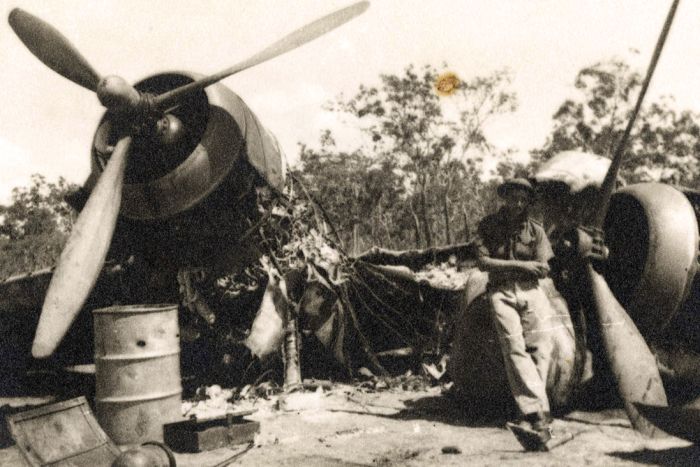World War II attacks outside of Darwin need more recognition, historians say
Posted
Historians are calling for more recognition that parts of northern Australia outside of Darwin were bombed by the Japanese in World War II.
While Darwin bore the brunt of the around 70 attacks spanning two years, many other centres were also bombed.
Barely a month after Darwin was decimated by a surprise Japanese bombing attack in 1942, the tiny town of Katherine was also attacked.
The bombing raid shocked the 300 or so residents who had thought that their location 270 kilometres inland from Darwin would keep them safe from the Japanese raids.
One man, Dodger Kodjalwal, was killed when he ran from the hospital in fright, according to the curator of the Katherine Aviation Museum Simmone Croft.
"On March 22, about 12:20pm, Katherine was bombed by nine planes and roughly between 89 and 92 bombs were dropped," she said.
"This was the furthest south the Japanese actually bombed."
Katherine bombing may have been a mistake
Ms Croft and Katherine's former MLA Mike Reed have written a book on the bombing there.
She said she was inspired to write the book because nothing else had been published on the bombing of Katherine.
 Photo:
It is possible Katherine was bombed by accident as the Japanese sought to attack the Manbulloo base. (Image: Courtesy of the Katherine Museum)
Photo:
It is possible Katherine was bombed by accident as the Japanese sought to attack the Manbulloo base. (Image: Courtesy of the Katherine Museum)
But her research has shown Katherine may not have been the target; it's possible the Japanese had actually wanted to bomb the nearby Manbulloo base, 17km south-west of the town.
One of the reasons the bombing of Darwin is the focus of commemorations is because poor air defences meant the first raid in February 1942 was almost unopposed, which allowed the Japanese to inflict maximum damage, according to historian Anthony Cooper.
Japanese forced to attack from higher altitudes
After the initial shock, the United States Air Force brought in three squadrons of P-40 Kittyhawks, which could match the Japanese Zero fighters in the air and were far superior to anything the fledgling Royal Australian Air Force had at the time.
The air resistance from the Allies over Australia meant the Japanese bombers had to attack from higher altitudes in subsequent raids.
"With the technology at the time, bombing from high altitudes meant you pretty well missed your target in most cases," Mr Cooper said.
While Australia relied solely on the United States in 1942, by the time the bombing season began in 1943 the RAAF had acquired three squadrons of Spitfires from the UK, two of which were flown by Australian pilots.
"The presence of the British squadron was a powerful propaganda for Imperial solidarity, suggesting to the people of Australia that Australia hadn't been quite as forgotten as they thought they were," Mr Cooper said.
Bombing attacks occurred right across northern Australia, from Exmouth in Western Australia to Townsville in Queensland.
Attack on Milingimbi
During the war the RAAF had established a base on the remote island of Milingimbi, 445km east of Darwin on the remote Arnhem Land coast, and Army and Navy units were also stationed there. .
The first attack on Milingibi on May 19, 1943 went virtually unopposed as the RAAF was caught almost off guard.
As a result a Navy supply ship, HMAS Maroubra, was sunk in the water nearby and a Beaufighter plane was destroyed on the ground. An Indigenous man was killed.
 Photo:
The supply ship HMAS Maroubra after being attacked off the coast of Milingimbi. (Australian War Memorial 300992)
Photo:
The supply ship HMAS Maroubra after being attacked off the coast of Milingimbi. (Australian War Memorial 300992)
Local historian Bob Baker said some of the Aboriginal people were playing cards when they saw the bombers coming but wrongly assumed it was RAAF aircraft, until they saw bombs falling.
"Everybody scattered, but these blokes playing cards out in the open, one of them was killed and the others were struck by shrapnel."
But that afternoon half a squadron of Spitfires was sent to Milingimbi, which met a follow up attack in a desperate and disorganised defence the next day.
"There were nine [Japanese] Zeroes against five Spitfires, so we were almost outnumbered by two to one."
Yet the Spitfire pilots managed to destroy two or possibly three enemy planes and damage two others.
'Beloved missionary' abducted, killed
Mr Baker supported calls for more recognition of attacks outside of Darwin.
He pointed to abduction of the local Reverend Leonard Kentish in January 1943, who was later beheaded in Indonesia, as an example of a story that deserved more attention.
"I'm sure that had an effect on the local people. They were beloved missionaries," Mr Baker said.
 Photo:
Spitfire pilots were sent to Milingimbi after it was attacked by Japanese bombers. (Australian War Memorial P11530.008)
Photo:
Spitfire pilots were sent to Milingimbi after it was attacked by Japanese bombers. (Australian War Memorial P11530.008)
Topics: world-war-2, katherine-0850, milingimbi-0822, exmouth-6707, townsville-4810, darwin-0800








